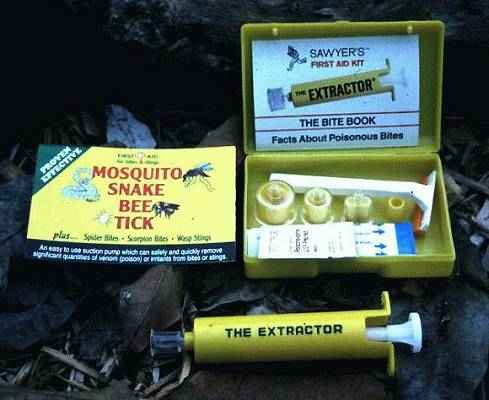
Using a Sawyer Extractor (Reverse Syringe)
- Allow bite to bleed freely for 15-30 seconds.
- Wash the bite with soap and water. If the victim is not allergic to iodine or shellfish, then cleaning and disinfecting the bite area with a Betadine pad is recommended.
- Wrapping above the bite with compression-type or wide elastic bandages (ACE) safely slows the spread of venom. These wraps should be placed 1-2 inches above the bite, with the area of fang marks left open. Do not wrap tighter than you would for a sprain and make sure a pulse can be felt adjacent to the bite. If no pulse is present, loosen the wrapping.
- Attempt to stop the spread of venom with one of the following methods:
- If a reverse syringe (Sawyer Extractor) is available, apply mechanical suction using the extractor until there is no more drainage from the fang marks. The extractor can be left in place for 30 minutes or more, and helps slow the spread of venom. It may actually suck some venom out of the wound as well.
OR
- If an extractor not available and the victim is allergic to iodine or shellfish, fold a 4 x 4 gauze pad in half twice, and use the pad to apply direct pressure over the bite.
OR
- If an extractor not available and the victim is not allergic to iodine or shellfish, soak a 4 x 4 gauze pad in Betadine, fold it in half twice, and use the pad to apply direct pressure to the bite.
- Immobilize the bitten limb, with a splint if available, and keep the limb at heart level or in a gravity-neutral position. Raising the limb higher than the heart can cause the venom to spread, and holding the limb below heart level can increase swelling.
- Try to identify the offending snake. Visual identification or description usually suffices.
- Go to the nearest hospital or medical facility as soon as possible. Antivenom is the only treatment for a poisonous snakebite, and you must get the necessary dosage just as soon as possible. Up to 20 vials may be needed to neutralize the effects of a rattlesnake bite, and children may need more vials than adults.
What Not to Do if Bitten by a Venomous Snake
- DO NOT remove elastic bandages, compression wraps, or reverse syringes (Sawyer Extractors) until the victim is at a facility ready to administer antivenom. As soon as the bandages are released, venom will spread, causing the usual expected problems of a venomous snakebite.
- DO NOT eat or drink anything unless okayed by a doctor, nurse or paramedic.
- DO NOT engage in strenuous physical activity.
- DO NOT apply oral (mouth) suction to bite.
- DO NOT cut into or incise bite marks with a blade.
- DO NOT drink alcohol or use any medication.
- DO NOT apply either hot or cold packs.
- DO NOT apply a narrow, constrictive tourniquet such as a belt, rubber band, or cord.
- DO NOT use a stun gun or electric shock of any kind.
- DO NOT remove dressings/elastic wraps until arriving at a hospital where antivenom is immediately available.
- DO NOT waste time or take any risks trying to kill, bag or bring in the offending snake.
Antivenom is a commercially sold serum used to treat snakebites. It is made by injecting specific snake venom into horses, so that the horse blood builds immunity by forming antibodies. Because many people have dangerous allergic reactions to antivenom, only trained medical staff should inject antivenom into a snakebite victim, and injection should be done only where complete emergency care is available.
|

